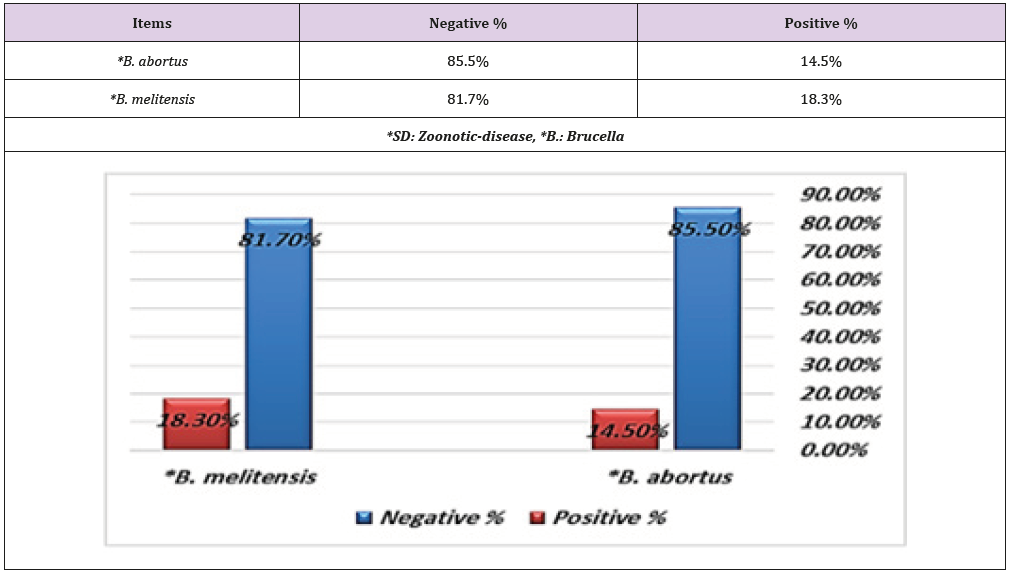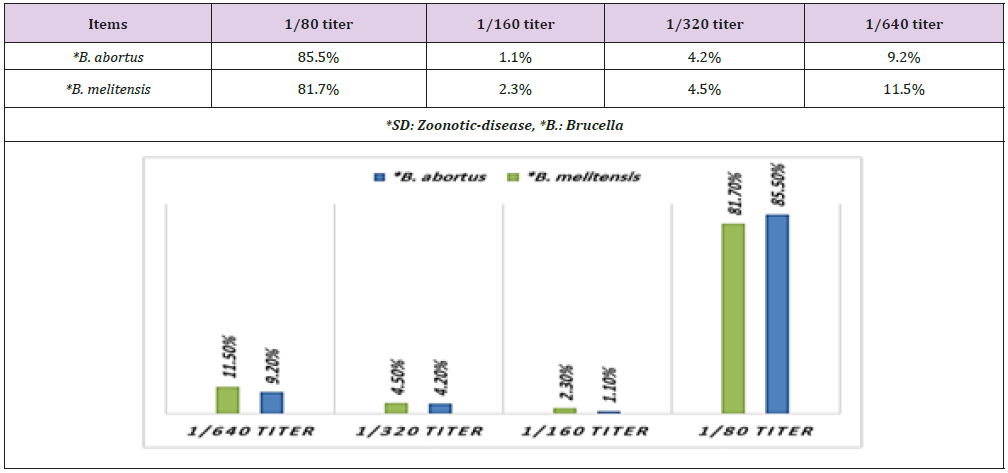Abstract
This paper was for discharge of “Serological-Diagnosis (SD) for Zoonotic-Disease (ZD) Pediatric-Brucellosis (PB) by Gold-Standard (GS) Affecting Community-Pediatric- Health (CPH) at High-Altitude (HA) Area, Taif, KSA”, the negative infections by Brucella (B.) abortus was 85.5%, and B. melitensis was 81.7%. Positive infections by B. abortus was 14.5%, less than by B. melitensis was 18.4%. The 1/80 titer difference between negative B. abortus than B. melitensis was about 4%. In the positive, the difference was found in the titer 1/160 were about 1.2%, 1/320 was 0.3% and 1/640 was 2.3% respectively. Titer 1/640 indicated the disparity of infected cases from the old; the patient had old infection and was the highest IgG. Recent infection was less than the indication of the preventive measures used to reduce the common diseases, including veterinary care for farms and the quality of manufacturing milk and milk products Lack of modern infections may be ways to protect a CPH from ZD as well as to protect livestock from infection. Concluded from that, the ZD as BP can be easily spread from animals to children through milk and its product. As well, the animal as sources of infection is too hard for CPH. Management of milk product can help in happened of ZD as PB and affecting CPH. Recommended for Vet. Observation must be clear for farms, milk and its product must not use from “House Made”, that all for protect CPH at Taif HA area.
Keywords: Serological-Diagnosis; Zoonotic- Disease; Pediatric-Brucellosis; Gold-Standard; Community- Pediat - ric-Health; High-Altitude
Abbreviations: SD: Serological-Diagnosis; ZD: Zoonotic-Disease; PB: Pediatric-Brucellosis; GS: Gold-Standard; CPH: Community-Pediatric-Health; HA: High-Altitude
Introduction
Brucellosis is a significant ZD causes by B., it has several species, and are differ in virulence, more famous in KSA are B. (melitensis and abortus) [1]. Reservoirs of B. melitensis is in (sheep, goat and camel) and B. abortus is in (cattle) [2]. That causing an economic burden in animal host, which present in unpasteurized raw milk and its dairy products [3]. Human got infections by inhalation, handling animals or animal carcasses such as meat, blood, urine, vaginal secretions, placenta, and fetus [4].
According to World Health Organization (WHO) reported brucellosis during 1998, KSA had the highest incidence of human brucellosis in the Eastern Mediterranean Region [5]. Among the Middle Eastern Region, KSA had stated advanced occurrence of brucellosis [6].
PB is most dangerous ZD [7], PB was a major health worry in KSA, high occurrence had credited to living in near livestock and drink raw milk, failures in veterinary healthiness control systems exposed limits [8]. At 2012, PB countrywide occurrence spread was unidentified [9]; it had an annual occurrence of 8-50 cases/105 people [10]. At 1999, PB had reported in KSA 10% [11], at 2017, PB had throughout the past 4 years in Najran, south KSA 2/3 cases were diagnosed in 10.5% [12], at 2019, PB at Al Baha were B. melitensis 74% and B. abortus 26% [13].
The aims of this work were for study SD for ZD for PB by GS to deliver preliminary opinion material and the first signs about an extent at HA area, Taif, KSA. As well was considered affecting CPH. This study will be the firstly report the incidence of ZD as PB by GS at Taif HA area, KSA.
Methodology
Research Area: Taif HA area was studied for the collection of blood samples from private hospitals after had approvals from hospitals and children parents. That was with condition did not record any personal or family information [14].
Serological Diagnosis (SD): Detection of IgG by Rose Bengal Plate Test (RBPT) [16], so that were gave positive or negative as start for diagnosis. If it was positive must made Serum Agglutination Test (SAT) titration for B. (abortus and melitensis) [17]. If it is 1/80 and below will consider negative, and more than 1/80 will consider positive [17].
Data Analysis: It was used “Simple Basic Excel Formulas” for management data for result in tables and diagram [18].
Table 1 and Graph 1 showed mean prevalence of total SD results, which showed RBPT detection of IgG, the negative infections by B. abortus was 85.5%, that was more than infections by B. melitensis was 81.7%. That’s where the opposite was in the positive infections in B. abortus was 14.5%, which less than infections by B. melitensis was 18.4% [1-4].
The KSA society had the livestock of (sheep, goats and camels), which was the highest than of cows where it was a source and a reservoir of B. melitensis, which was definitely the main source of infection. As well, this was an evident from the positive infection by B. melitensis was more than infection by B. abortus that was about than other by about 4% [1-6].
Milk and products were present in the “Municipal Markets” in Taif as HA Area and may be prepared locally at house (House Made). That observed bacteria have not eliminated well in a healthy way. That the home manufacturing was incomplete or good. So, eating milk or products could lead to the occurrence of infection, especially for children as ZD and a common disease, so that would affect CPH [7-13].
Table 2 and Graph 2 showed mean prevalence of distributed SD results according to titration, by SAT detection of IgG titration, through 1/80 titer that found which considered negative and less, more than titer 1/80 were calculated positive. That found the difference between negative in B. abortus than B. melitensis was about 4%. In the positive, the difference was found in the titer 1/160 were 1.2%, 1/320 was 0.3% and 1/640 was 2.3% respectively [1-6].
Titer 1/640 indicated the disparity of infected cases from the old that one’s prove that the patient had infected for a long time and was the highest proportion of IgG [7-13]. Recent infection was less than the indication of the preventive measures used to reduce the common diseases, including veterinary care for farms and the quality of manufacturing milk and milk products. Lack of modern infections may be ways to protect a CPH from ZD as well as to protect livestock from infection [7-13].
Conclusion
ZD as BP can be easily spread from animals to children through milk and its product. As well, the animal as sources of infection is too hard for CPH at Ha area. Management of milk product can help in happened of ZD as PB and affecting CPH.
Recommendation
Vet. Observation must be clear for farms, milk and its product must not use from “House Made”, that all for protect CPH at Taif HA area.
Acknowledgment
That were sent many thanks for each person help in produce this paper.
Conflict of Interest
There was not any conflict of interest because there were not present of same paper.
References
- Bikas C, Jelastopulu, E, Leotsinidis M, Kondakis X (2003) Epidemiology of human brucellosis in a rural area of north-western Peloponnese in Greece. Eur J Epidemiol 18(3): 267-274.
- Lucero E, Ayala M, Escobar I, Grayon M, Jacques I (2006) A new variant of Brucella melitensis. Clin Micro Infect 12(6): 593-596.
- Smits L, Kadri M (2005) Brucellosis in India: A deceptivinfectious disease. Indian J Med Res 122(5): 375-384.
- Khan Y, Mah W, Memish A, (2001) Brucellosis in pregnant women. Clin Infect Dis 32(8): 1172-1177.
- Gwida M, Dahouk S, Melzer F, Rösler U, Neubauer H, et al. (2010) Brucellosis-Regionally Emerging Zoonotic Disease? Croat Med J 51(4): 289-295.
- Refai M (2002) Incidence and control of brucellosis in the near east region. Vet Microbiol 90(1-4): 81‑
- Njeru J, Wareth G, Melzer F, Henning K, Pletz W, et al. (2016) Systematic review of brucellosis in Kenya: Disease frequency in humans and animals and risk factors for human infection. BMC Public Health 16(1): 853.
- Kamal H, Al-Gashgari B, Moselhy S, Kumosani A, Abulnaja O (2013) Two-stage PCR assay for detection of human brucellosis in endemic areas. BMC Infect Dis 13: 145.
- Hotez J, Savioli L, Fenwick A, (2012) Neglected tropical diseases of the Middle East and North Africa: Review of their prevalence, distribution, and opportunities for control. PLoS Negl Trop Dis 6(2): e1475.
- Pappas G, Papadimitriou P, Akritidis N, Christou L, Tsianos V (2006) The new global map of human brucellosis. Lancet Infect Dis 6(2): 91-99.
- Al‑Sekait A (1999) Seroepidemiology survey of brucellosis antibodies in Saudi Arabia. Ann Saudi Med 19: 219‑2
- Ghadi A, Nagah A, Iman N, Atheer A, Albatool A, et al. (2017) Pattern of childhood brucellosis in Najran, south Saudi Arabia in 2013-2017. Electronic Physician 9(12): 5902-5907.
- Mahmoud R, Carmen N (2019) 10.1136/archdischild-2019-epa.724 Arch Dis Child: first published as 10.1136/archdischild-2019-epa.724 on 12 June 2019.
- http://www.lifesciencesite.com/lsj/life1006s/2019
- (2019) Blood Specimens: Chemistry and Hematology.
- (2019) Rose Bengal plate test (RBT) for Brucella: Principle, Procedure and limitation.
- (2016) Serology for Brucellosis.
- (2019) Basic Excel Formulas.

 Short Communication
Short Communication

